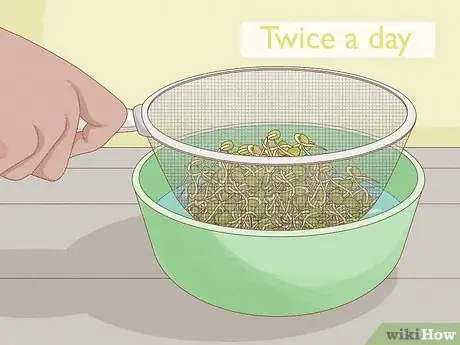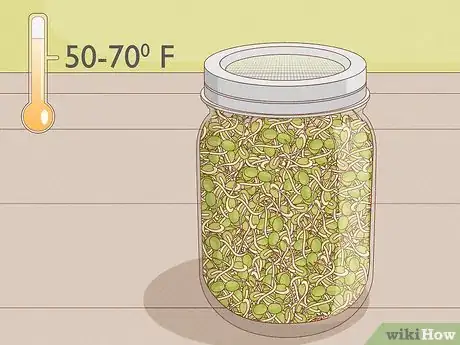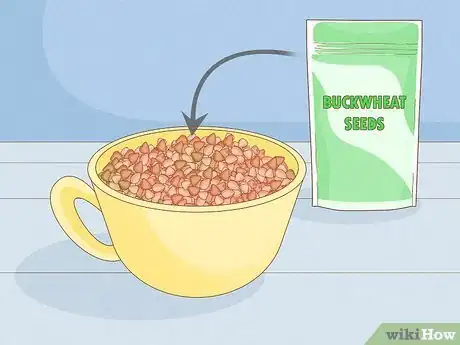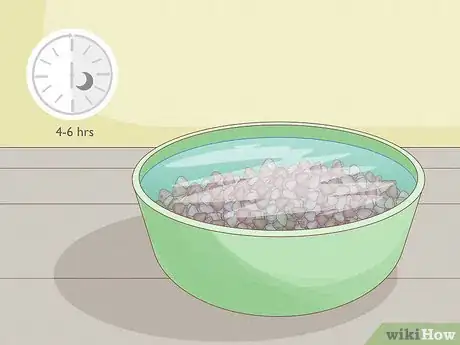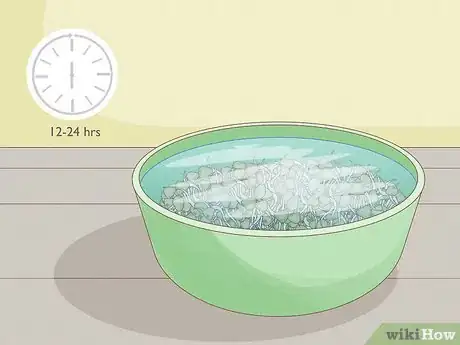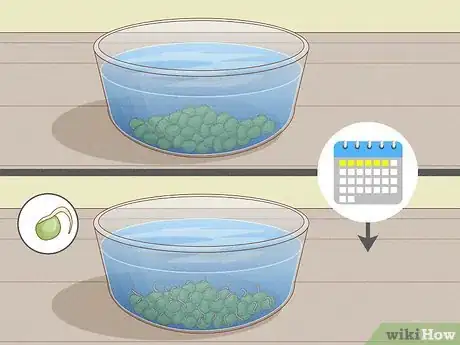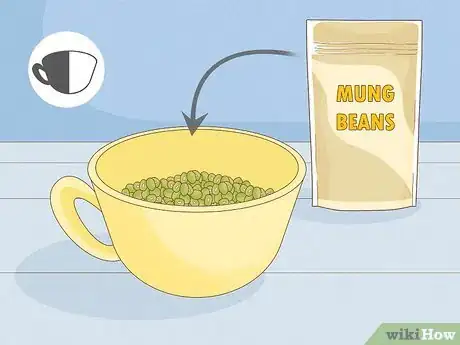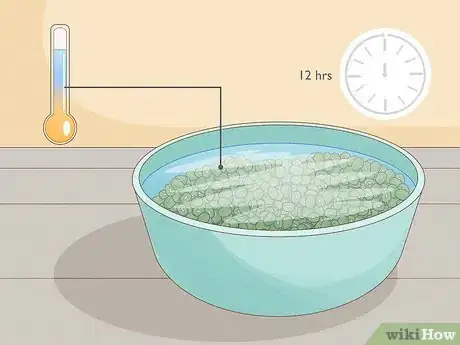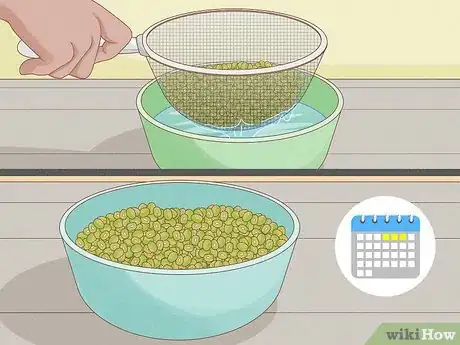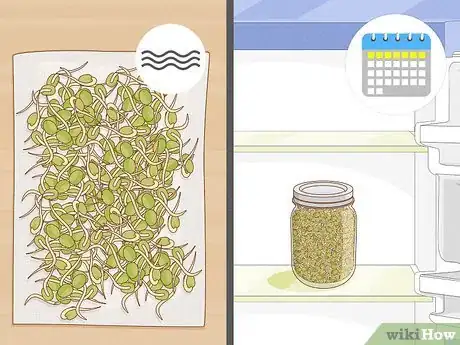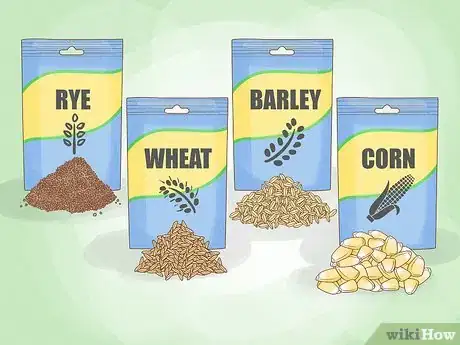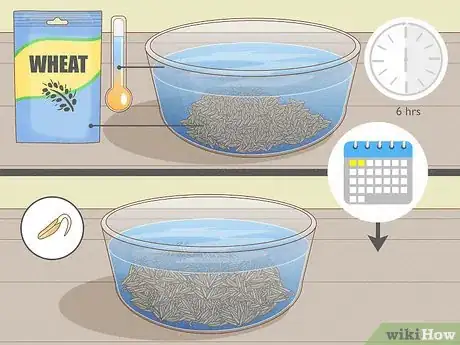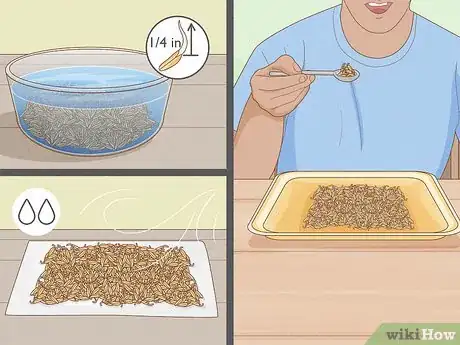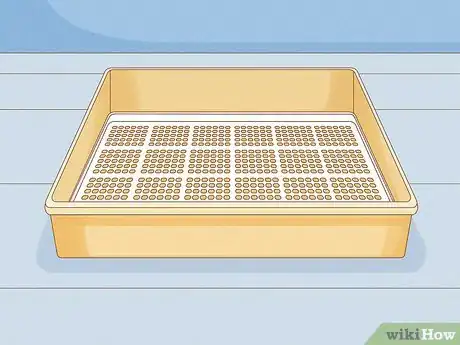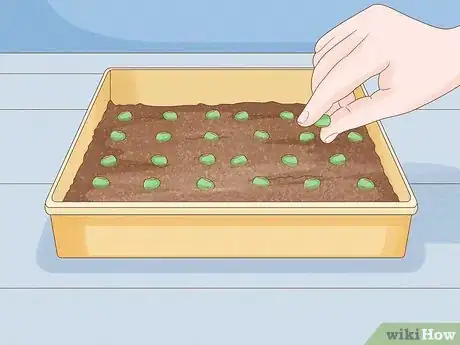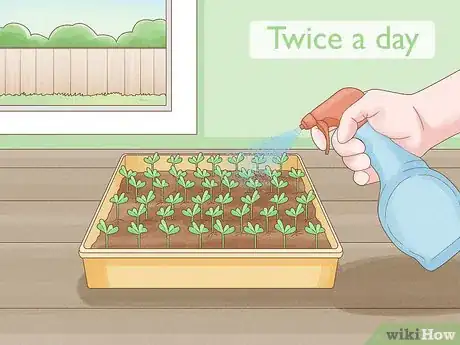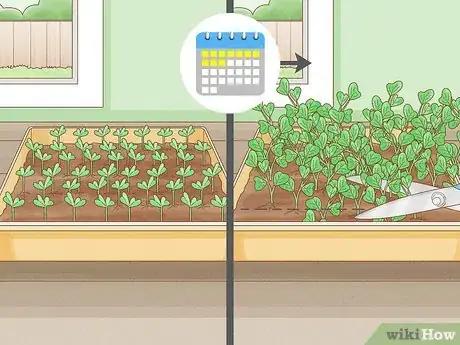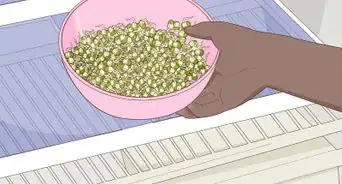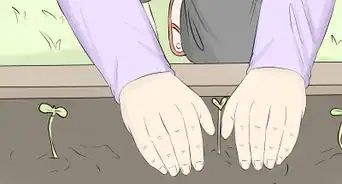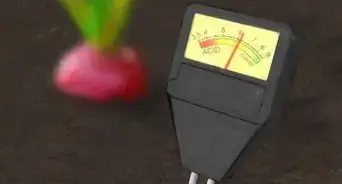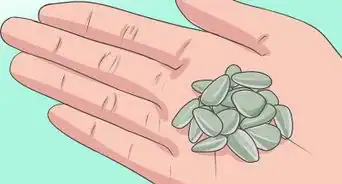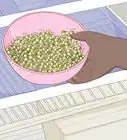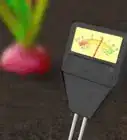This article was co-authored by Andrew Carberry, MPH. Andrew Carberry is a Food Systems Expert and the Senior Program Associate at the Wallace Centere at Winrock International in Little Rock, Arkansas. He has worked in food systems since 2008 and has experience working on farm-to-school projects, food safety programs, and working with local and state coalitions in Arkansas. He is a graduate of the College of William and Mary and holds a Masters degree in public health and nutrition from the University of Tennessee.
This article has been viewed 130,193 times.
Sprouting beans, vegetables, seeds, and grains is a simple way to exponentially increase the nutrition factor of simple ingredients. By sprouting up some alfalfa or lentils, you can intensify the micronutrients and integrate a delicious active food into your diet. They're delicious and a surprising treat you can make at home with a small number of ingredients and steps. Learn the basic process and the specific instructions for legumes, grains, seeds, and even how to grow your own microgreens. See Step 1 for more information.
Steps
Basic Guidelines and Materials
-
1Select a type of sprout to start with. Organic seeds, beans, or nuts are all sproutable, using the same basic method. Make sure you get organic, or pesticide-free seeds intended for edible sprouts. Many commercial seeds, used for planting, are pre-coated with fungicides, pesticides, and other things that you won't want to eat. Experiment with a variety of seeds and legumes to learn what kind of sprouts you like best. It takes a minimal amount of preparation and supplies to start. Select between:
- Seeds like sesame, sunflower, buckwheat, or pumpkin
- Legumes or beans like mung beans, lentils, chickpeas, adzuki, or green peas
- Whole grains like barley, corn, wheat, quinoa, amaranth or rye
- Vegetable seeds like alfalfa, clover, radish, kale, cabbage, fenugreek, or turnip
-
2Soak the seeds in a jar overnight with filtered water. Pour in enough water to cover the seeds and let sit. Cover the top with cheesecloth, or some type of repurposed mesh: a woman's stocking, a section of screen, anything you could cinch on top and drain through would be perfect.
- Any type of clean glass jar is perfect for making sprouts. Old pickle jars, mason jars, or other glass containers can be repurposed for sprouts. If you've still got the metal ring around the mouth of the mason jar, you can use it to hold the mesh covering in place, or you could use a hair tie, rubber band, or other elastic band to do the same. You can also buy a plastic sprouting lid with a mesh top for draining sprouts.
- If you want to sprout microgreens like arugula, wheatgrass or pea shoots, you'll also need seed beds, soil, and a bit more time on your hands.
Advertisement -
3Drain the soak water and rinse your sprouts twice a day. In general, you should rinse any type of sprouts every morning and evening, then drain them thoroughly to promote germination, without removing them from the jar.
- When sprouting legumes, it's common to swirl some water in after a few days to break up the hulls and let the sprouts form.
-
4Maintain the proper environment for germination. You'll control the moisture by periodically rinsing the sprouts, but you'll also need to maintain an even temperature to promote germination. Keep your sprouts between 50 and 70 degrees F.
- If your home is especially cool at a particular time of year, you might need a heater. An 8-watt heater for reptile tanks placed under a sprouter will help without cooking them and ruining the germination.
- Some sprouts such as radish sprout better in darkness, but they will need to be in light after sprouting in order to turn green and grow larger. In general, most sprouts are perfectly fine in the daylight and normal room-temperature conditions.
-
5Use fresh sprouts right away. As soon as you're happy with the length of your sprouts, enjoy them on sandwiches, salads, or soups. Put any uneaten sprouts in the refrigerator. They'll keep in the fridge for about five days, but will eventually start to brown and get a little slimy, which means it's time to sprout more and toss these out.
- Each variety of sprout differs slightly in the length of time and the proper treatment of the sprouts, once soaked and germinated for several hours. Some can remain in the jar for a few days to grow longer and more tender, while others will need to be replanted onto a seed bed for optimum growth and deliciousness. Consult the specific section below for more information about the specific type of sprouts you want to grow.[1]
- Some sprouts will need to be dehulled after sprouting for several days. Swirl the sprouts in water to help separate the hulls, and be sure to drain afterwards.
Sprouting Seeds
-
1Start with about a cup of the seeds of your choice. Any organic and edible food-grade seeds would be perfect for sprouting. The soaking process opens up the hulls to activation the germination process, resulting in a nutritional snack that's not that different from the original seed, but loaded with nutrients.
- Edible seeds like pumpkin, sunflower, and sesame are commonly-sprouted. They're quick-working and delicious as a highly-nutritious snack.
- Vegetable seeds like clover, alfalfa, radish, cabbage, fenugreek, or kale make soft and tender sprouts loaded with micronutrients. These are the kind of sprouts most commonly served on sandwiches, small and light wisps of vegetable.
-
2Soak in cold water for between 4 and 6 hours. Measure the seeds into your sprouting jar and then cover them with cool filtered water, covering them by about an inch or so. If the seeds are particularly dusty, or covered in other sediment, give them a rinse first before adding the water.
- Let soak for 4 hours at room temperature. Leaving them directly on the counter top in your kitchen is fine. Then drain the water thoroughly and let the seeds start sprouting.
-
3Let edible seeds sprout for between 12 and 24 hours. After you've drained the water off, do nothing for about a day. The seeds will start activating as if they were preparing to grow, and you'll be well on your way to producing sprouts. After a day, they're ready to eat!
- After a day, remove the seeds from the jar and lay them out on a paper towel to dry thoroughly. Return them to a bowl or other container and keep them in the refrigerator. They should be good for several days, and ready to eat.
- Sesame seeds, in general, become quite bitter if left for longer than six hours. Try to catch them ahead of time, then dry them thoroughly.
-
4Let vegetable seeds sprout for about 6 days. Vegetable seeds will take a little longer to fully sprout to their desired length, as long as 5 or six days. While they're edible at any stage in the process, the resulting sprouts will usually be more tender and nutritious after a few days. Maintain regular rinsing and thorough drying, preferably storing the jar upside down so excess moisture can drain out and keep the sprouts fresh.
- Use your eyes and nose to check on the freshness of vegetable sprouts. They'll start to turn brown and smell slightly chlorinated when they turn.
-
5Consider sprouting nuts for immediate eating. Nuts like almonds, hazelnuts, and other oilseeds are commonly soaked for a few hours to "activate" their enzymes and make them more nutritious.[2] The nutritional benefit of soaking nuts to activate the germination before eating them is somewhat unconfirmed, but if you're interested in trying, it's an easy project.
- Only raw nuts will benefit from soaking. This will not work with roasted nuts.
Sprouting Legumes
-
1Select a bean or legume variety to sprout. Perhaps the heartiest and the most famous sprouts are the bean sprouts. Legumes sprout thick protuberances that are nutritious and taste great, full of active micronutrients and flavor. Common legumes for sprouting include:
- lentils, green or brown especially
- chickpeas or garbanzo beans
- mung beans, which are commonly sold in stores as "bean sprouts"
- green peas
-
2Soak legumes in warm water. Start with about a half cup of dried beans (they tend to plump up some as they absorb water and shake their hulls). The water shouldn't be steaming, but warm to the touch, like a cup of tea you've let sit a bit too long. In your sprouting jar, soak the beans for at least 12 hours.
- Because the legumes will plump up considerably, make sure there's enough space in the jar and cover the beans by several inches to make sure they'll stay submerged.
-
3Let sprout for about 3 whole days. Rinse the beans twice a day, and store them upside down to drain properly as the sprouts grow. Sometime the first or second day, you might need to shake the jar slightly to remove the hulls. You can add some water and swirl the jar gently to remove them. If some stay on, don't worry to much. You'll be able to pull them off before eating, if necessary.
- Adzuki beans typically need about 4 days to sprout to their fullest and most delicious potential. Give them some extra time.
-
4Dry off the sprouts and store them in the refrigerator. After the sprouting period is over, you can remove the sprouts from the jar, gently dry them out and remove any extra hulls that haven't separated, or you can leave them on (they're edible, though somewhat bitter). They should be good in the fridge for about a week, if you keep an eye on them and keep them relatively dry.
- Bean sprouts are particularly good as a topping for broth-based soups, like Vietnamese pho or other spicy dishes. They're also perfect on salads and sandwiches.
Sprouting Grains
-
1Choose a grain to sprout as a raw alternative. Because whole grains aren't digestible unless cooked, it makes it difficult for raw food enthusiasts to enjoy them. Sprouting grains, however, makes them easily digestible and nutritious. Without cooking, you can enjoy whole grains like rye, wheat, barley, or corn, without baking and breaking down their micronutrients.
- Sprouting grain neutralizes difficult-to-digest phytic acid, releasing vitamins and nutrients not generally present in raw grain. This makes it ideal for porridges, baking, and making into sprouted flour.[3]
- Hulled oats, like the kind you buy at the store to make oatmeal, won't sprout. To sprout grains, you need to buy whole grains still in their hulls, raw and organic. Other types of grains will just soak. You can ferment oatmeal with miso paste overnight, for a quick live culture option.
-
2Soak whole grains in warm water. Grain will triple in size over the soaking process, so it's important to start with a jar or bowl large enough to hold three times the amount of flour that you put into it to soak. Soak the grains for about 6 hours, then drain the water thoroughly and sprout them at room temperature for about 2 days. Rinse periodically and drain thoroughly.
- Corn needs to undergo a slightly longer presoak, about 12 hours before draining the water and letting it sprout.
- Amaranth, quinoa, and millet, commonly-mistaken for varieties of seed or rice, are actually alkaline grains, and are perfectly-sproutable using this method.
- Barley won't actually sprout, but you can activate the germination process, as is done when malting barley for making alcohol, by "sprouting" it for about 12 hours. This will activate the process and start breaking down the hull.
-
3Harvest the sprouts. Once the tip of the sprout is about 1/4 inch long, it is ready to be used. Rinse the grains one last time. Lay them on a dry towel, and let them dry. Use immediately, or store in the refrigerator.
-
4Make sprouted flour. To turn sprouted grains into flour, you'll need a food dehydrator and a grinder designed for grains. After they've sprouted, dehydrate the grains for about 12 hours and grind them into a fully-integrated and fine flour, sifting if desired. You can store this sprouted flour in the freezer to maintain it's life, and use it as you would any type of baking flour.[4]
Growing Shoots and Microgreens
-
1Sprout your greens for a more substantial project. The process for starting a small batch of microgreens like wheatgrass, pea shoots, or sunflower greens is remarkably similar, though slightly more equipment-intensive, than sprouting in your kitchen. You'll be able to trim multiple high-yield crops of sprouting greens from these projects, however, making them a good investment, especially if you're into wheatgrass shots or fresh shoots on your salad.
- Start your sprouts like normal, soaking wheat seeds, green peas, or sunflowers in a jar and letting them sprout for about before rinsing them thoroughly and moving them to a seeding tray.
- Sprouts need to have about quarter-inch roots showing before you move them to the seeding tray. Depending on what you're going to plant, this may take a varying amount of time, possibly 3 or 4 days.[5]
-
2Get some seeding trays. An outdoor sprouting system usually consists of trays for the sprouts to sprout and grow in, with mesh or holes on the bottom to drain from regular waterings. These are commonly available at gardening outlets, or you can make your own by punching some drain holes in the bottom of any sort of tray large enough to hold about a foot-square of soil.
-
3Line seeding trays with soil. Line your seeding tray with a generous amount of soil. You don't need much, since the sprouts will be mostly growing on top and not producing substantial root systems, but it's better to have enough to trap moisture so you don't need to worry about your starts drying out.
- Moisten the soil thoroughly with water and let any puddles dissipate before translating your sprouts onto the soil.
- It's also common to line the bottom of plating or sprouting trays with small sections of blanket to keep the soil moist from underneath, and to mix in a small amount of vermiculite--about a cup for a 10 x 10 tray--to promote growth.
-
4Bed the sprouts on the soil. Sprinkle your sprouts evenly on the top of the soil, spreading them out so none are piled on top of one another, which can cause molding. Use a covering tray, or a simple blanket or some sort, to cover the tray. Push down slightly on the seeds to seat them in the soil, but be gentle. You don't need to "plant" them.
-
5Water twice a day and keep them in low light. A few times a day, mist your sprouts and keep a close eye on them. Make sure they're getting enough water and air circulation to promote growth, and Try to keep them around room temperature, if possible. Growing sprouts in a shed with plenty of cool shade can be a nice place to keep your starts, like this.
-
6Harvest sprouts or grass in about 10 days. Wheatgrass will be tall and verdurous after about a week, but give it a few more days to reach it's full nutritional peak. Pea shoots will fill out and turn a lovely shade of green, and will be at their peak of tender deliciousness around the 10 day mark. Harvest the tops and let them continue growing, if you wish, or consider planting them to start your own crop.
Community Q&A
-
QuestionCan I end up getting sprouts that make me sick?
 Anaka BlackwoodCommunity AnswerIf you properly clean the sprouts before eating and grow them in safe, drinkable water, they should be fine.
Anaka BlackwoodCommunity AnswerIf you properly clean the sprouts before eating and grow them in safe, drinkable water, they should be fine.
Warnings
- Don't eat sprouts if they have gotten moldy from lack of proper drainage.⧼thumbs_response⧽
Things You'll Need
- Organic Seeds
- Sprouting jar, tray, or an automated sprouter
- Water source, and drain
- Screen
References
About This Article
To grow sprouts, start by soaking some sprout seeds in a jar of unfiltered water overnight. Then, drain out the water, and continue to rinse and drain the sprouts every morning and evening for 2 days. Make sure you keep the seeds somewhere between 50 and 70 degrees Fahrenheit so they germinate. Finally, wait for the seeds to sprout and grow until they reach your desired length. For more tips from our Food co-author, like how to grow different kinds of sprouts, scroll down!


